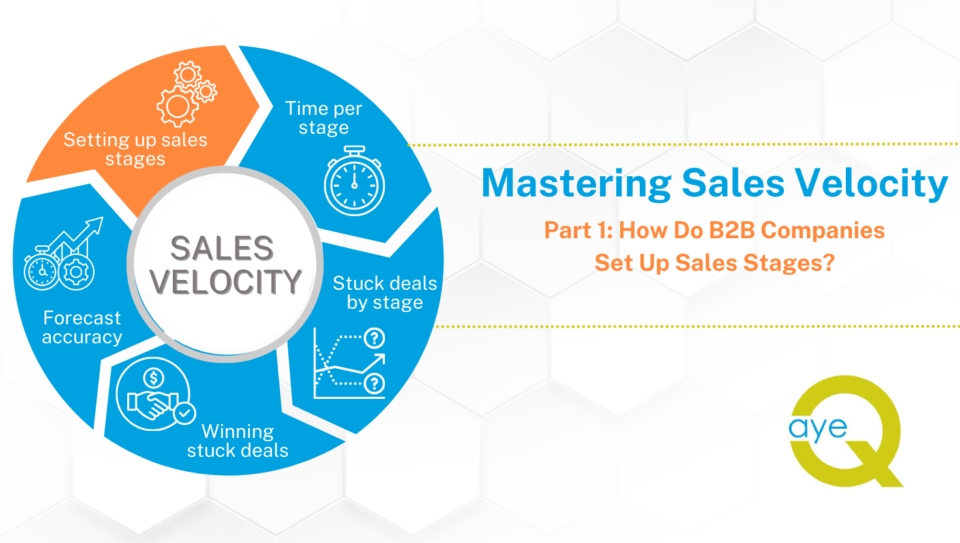How to Set Up B2B Sales Stages
In B2B sales, defining clear and structured sales stages is essential for tracking progress, forecasting revenue, and optimizing pipeline management. Yet, many companies struggle to set up stages in a way that truly reflects their sales process, leading to forecasting errors, stuck deals, and misalignment between revenue teams. A well-structured sales stage framework isn’t just about moving deals from left to right in a CRM—it’s about understanding the velocity of revenue and ensuring sales teams focus on the right opportunities at the right time.
Editor’s Note: This is Part 1 of a 5-Part Series about B2B Sales Velocity.
The Purpose of Sales Stages in B2B Sales
Sales stages exist to create a standardized view of how opportunities progress through the funnel. Each stage represents a critical milestone in the buying journey, allowing sales teams to:
- Measure pipeline health by seeing how deals progress through each stage.
- Identify bottlenecks where deals are stalling.
- Improve forecast accuracy by predicting how many deals will convert at each stage.
- Align marketing, sales, and customer success around a shared understanding of the customer journey.
But while the concept is simple, execution is often flawed…
Common Mistakes in Defining Sales Stages
Most B2B companies follow a generic sales stage framework, such as:
- Discovery – Initial engagement and qualification.
- Solution Presentation – Demonstration of value.
- Proposal – Pricing discussion and contract negotiation.
- Decision – Final approvals and commitment.
- Closed Won/Lost – Deal completion.
While this structure may seem logical, it often doesn’t reflect the realities of a company’s specific sales cycle. Common mistakes include:
- Too many or too few stages: Too many create complexity and administrative burden, while too few lack the granularity needed for real insights.
- Vague exit criteria: If sales reps aren’t clear on what qualifies a deal to move to the next stage, inconsistencies emerge.
- No differentiation between deal types: Different revenue streams—new logos, renewals, upsell, cross-sell, and different geographies—each have unique velocity patterns that should be accounted for in stage definitions.
The Assumptions Companies Make About Stage Timing
Another key challenge is that most companies make broad assumptions about how long a deal should stay in each stage. Many use arbitrary timeframes, such as, “If a deal has been in the Proposal stage for 90 days, it’s probably dead.” But how do you know what “too long” really means?
Without a data-driven approach, these assumptions can mislead sales teams. Some companies rely on the average time in stage across all deals, but this doesn’t reflect the ideal sales cycle. A better approach is to look at the average stage age of won deals—this provides a more accurate benchmark for successful deal progression.
The Role of Sales Velocity by Stage
Sales velocity isn’t just about how quickly deals move through the pipeline—it’s about understanding how long they should take. If you track the time it takes for successful deals to progress through each stage, you can set realistic expectations. For example:
- If the average time in the Proposal stage for won deals is 30 days, then a deal sitting there for 60 days is likely stalled.
- If a deal is 2x the ideal stage length, it should be flagged as at-risk.
- If enterprise deals take longer than SMB deals, stage benchmarks should be set accordingly.
- If an upsell takes half the time of a new logo, that should be factored into stage progression expectations.
A More Intelligent Approach: How To Set Up B2B Sales Stages
To get the most out of sales stages, companies should:
- Base stage timing on won deals, not all deals.
- Set “stuck” criteria based on a multiple of the ideal stage length.
- Differentiate stage benchmarks by revenue stream, geography, and deal type.
This approach moves beyond traditional pipeline hygiene and into predictive revenue modeling, enabling teams to focus on deals with the highest probability of closing. By using data-driven insights rather than guesswork, companies can significantly improve sales velocity and forecasting accuracy.
Ready to advance on to how long you should plan for deals to stay in each B2B Sales Stage? Check out Part 2 in our Series: Flawed Assumptions About Sales Stage Times.
